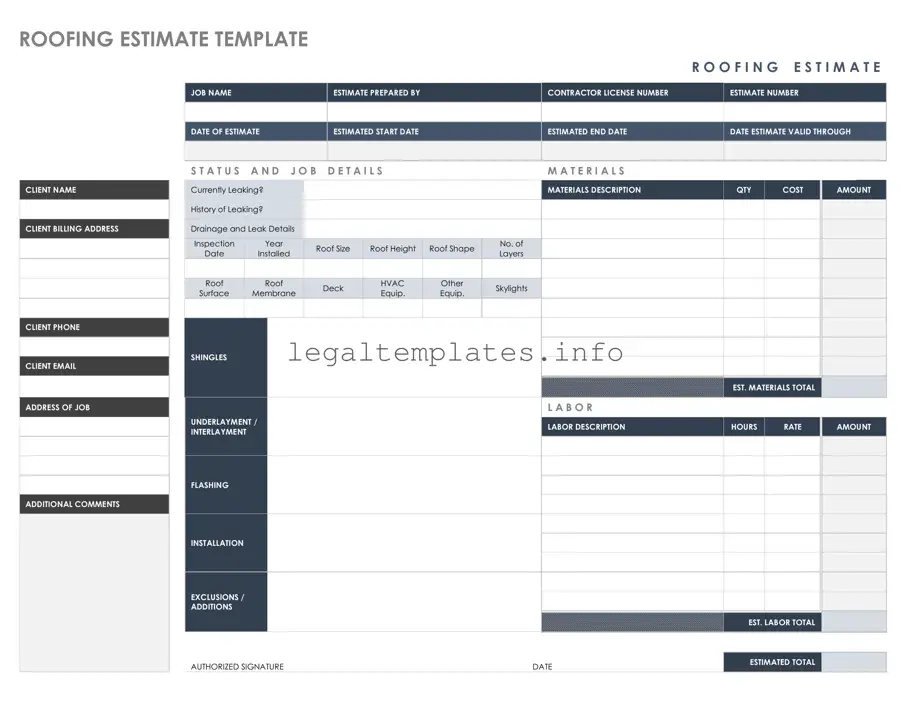The Roofing Estimate form shares similarities with a Construction Contract, as both documents delineate the scope of work, materials to be used, labor, and costs associated. A Construction Contract typically details the agreement between the homeowner and contractor for the entire project, whereas a Roofing Estimate may focus specifically on the roofing aspect, but the essence of outlining project specifics and financial terms connects them closely. These documents ensure both parties have clear expectations before work commences.
Similar to a Roofing Estimate, an Invoice serves a related but distinct purpose. While an estimate provides a prospective cost of roofing services, an Invoice is issued after the work has been completed, detailing the final cost. Both documents itemize the services provided but differ in timing; estimates are anticipatory, whereas invoices are conclusive, reflecting actual costs.
A Work Order, much like a Roofing Estimate, outlines specific tasks to be completed but is often more directive. It acts as an authorization for the contractor or service provider to start work, detailing the job's location, necessary materials, and labor requirements. While the Roofing Estimate offers a financial projection, a Work Order organizes and schedules the actual execution of tasks, thereby operationalizing the estimate's financial and logistical assumptions.
Material List documents, akin to the Roofing Estimate, list all materials required for a specific project. The primary difference is in scope and detail. While the Roofing Estimate includes a cost breakdown and an overview of materials alongside labor charges, a Material List dives deeper into specifics, including quantities, brands, and model numbers, without discussing service costs or labor, focusing exclusively on inventory needs.
The Project Timeline document shares a common goal with the Roofing Estimate by setting expectations for the duration of the roofing project. However, the Project Timeline emphasizes specific milestones and completion dates rather than financial details or material specifications. It aligns both the contractor and homeowner on timing expectations, ensuring a mutual understanding of the project's flow from start to finish.
Change Order Forms are utilized when modifications to the original plan or agreement, such as those outlined in a Roofing Estimate, are necessary. These documents record any changes to the work scope, materials, costs, or timeline agreed upon initially. They are essential for maintaining transparency and agreement on alterations, ensuring any deviations from the original estimate are documented and approved by all parties involved.
A Proposal Letter, while broader in scope, serves a function similar to that of a Roofing Estimate, in that it aims to pitch a service or project plan to a potential client. However, it teeters more on the persuasive side, often highlighting the qualifications of the service provider and the benefits of selecting them for the job, in addition to providing a preliminary overview of costs and project timeline, much like the estimate.
Warranty Documents can be considered complementary to Roofing Estimates. While the latter forecasts the cost and scope of roofing work, Warranty Documents spell out the quality and durability guarantees of materials and workmanship. They play a crucial role in providing assurance to the homeowner, specifying what repairs or replacements are covered should issues arise post-completion.
The Home Inspection Report, though not a contractual document like a Roofing Estimate, shares the similarity of itemizing issues or potential concerns with a property, often including the roof. Where an estimate assesses the cost for addressing such issues, the inspection report identifies them, providing a basis on which the need for a roofing estimate might be founded. It's a crucial document that precedes and often necessitates the creation of a Roofing Estimate.
Finally, the Bid Proposal parallels the Roofing Estimate in its function of offering a detailed projection of project costs to the homeowner, yet it is inherently competitive. Crafted by contractors vying for a job, it meticulously outlines their plan, costs, and timeframe to persuade a homeowner of their value proposition. While a Roofing Estimate might be requested by the homeowner after selecting a contractor, a Bid Proposal is unsolicited, aiming to secure that selection.

